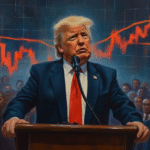- Main event, leadership changes, market impact, financial shifts, or expert insights.
- Trump announces tariffs amidst U.S.-EU trade talks collapse.
- Financial impact expected on global markets and cryptocurrencies.
Donald Trump has announced a 50% tariff on all European Union goods set to begin June 1, 2025, as negotiations between the U.S. and EU stall.
The proposed tariffs on EU goods highlight a significant escalation in trade tensions between the United States and the European Union. Markets have reacted with volatility.
In the recent announcement, Donald Trump threatened a 50% tariff on all EU goods as trade talks with key European leaders falter. Apple’s CEO Tim Cook was also urged to move iPhone production to the U.S.
The announcement resulted in market volatility, with Bitcoin dipping below $109K. The EU has paused its tariffs but indicated readiness to retaliate if talks fail. “We are prepared for countermeasures on up to €95 billion ($107.6 billion) of U.S. imports if tariff negotiations with Washington fail,” asserted the European Commission. These tensions could impact consumer and trade sectors significantly.
The potential financial ramifications include shifts in global trade patterns and economic policies. Both the U.S. and EU are preparing for escalatory fiscal measures. These developments could lead to temporary reductions in capital flows into certain sectors.
Historically, similar tariffs initiated by Trump resulted in increased volatility for equities and cryptocurrencies, affecting global trade sentiment. Affected markets might see short-term impacts on institutional investments and liquidity. These factors contribute to the potential for a challenging economic environment across affected regions.
“The European Union, which was formed … has been very difficult to deal with in trade negotiations.” — Donald Trump, President of the United States






